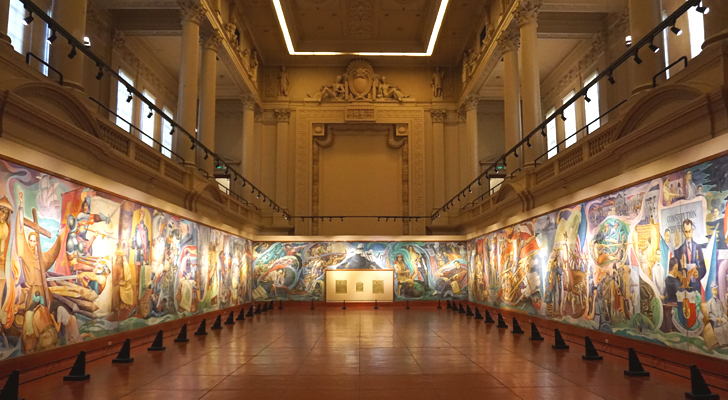“This is my favorite spot in Manila,” I told my buddy as we stared at Juan Luna’s magnum opus, The Spoliarium. We were then at the National Museum of Fine Arts, one of the neoclassical buildings around Luneta Park in the Philippine capital.
By that time, I began to catch my breath too. I remember that we almost were not allowed entrance to the museum since we arrived after its cut-off or 15 minutes before it closes.
“My good friend is actually from Malaysia sir,” I pleaded with the security personnel stationed at the gate. “I just want him to see the Spoliarium. That’s all.”
Thankfully, he relented perhaps only after I presented the “so-I-have-this-foreigner-friend” card.
Spoliarium and the Rizal connection
The Spoliarium, which is massive at 4 m x 7 m, won the first gold medal during the 1884 Exposición Nacional de Bellas Artes in Madrid. It depicts a scene in a chamber of a Roman arena – men dragging defeated gladiators, onlookers watching the bloody spectacle and a woman grieving on one side.

Perhaps Luna saw the striking parallel between the plight of these lifeless men and those of the oppressed Filipinos during his time. It is said that Jose Rizal, who was still a student back then, understood very well the message conveyed in the painting. In a post-celebration of Luna’s and Felix Ressurreccion Hidalgo’s (another Filipino painter) double victories, Rizal boldly declared in a toast, the end of the colonial patriarchy.
He would later publish two controversial novels and launch a short-lived civic organization. Because the Spanish authorities believed that these fueled the brewing revolution in the Philippines, they convicted him of rebellion, sedition and conspiracy.
On December 30, 1896, Rizal was executed at Bagumbayan, the present day Luneta. The beautiful irony is that it is just a few minutes walk from the museum where the Spoliarium is currently displayed.

Since we still have time to spare, we breezed through the other galleries. After seeing Luna’s Parisian life (smaller in scale compared to the Spoliarium yet considered to be one of the most expensive paintings in the Philippines) and Carlos ‘Botong’ Francisco’s jaw-dropping mural, we went back to the Spoliarium for one last look.
The National Hero and the national photobomber
“Bro, that’s our national photo bomber,” I pointed to the direction of the 49-storey Torre de Manila. “You’ll know why in a little bit,” I added with a wry smile.
The moniker became more apparent as we neared the Rizal Monument. This is where our national hero’s remains are interred. (Technically, there is no legislation that officially recognizes him as the Philippines’ National Hero. But most historians agree that he is still ‘regarded as such by acclamation and tradition.’)

“Now I completely understand,” my friend said in jest as he saw how the controversial DMCI highrise looms over Rizal like a concrete Godzilla.
Its construction was actually halted midway via a Supreme Court TRO (Temporary Restraining Order) in June 16, 2015. Heritage advocates and especially the Knights of Rizal argued that the building ‘violates the constitutional provision on the conservation and promotion of the country’s historical and cultural heritage.’
The high court disagreed eventually. On April 25, 2017, the SC allowed Torre de Manila’s construction to continue as there is no law that prohibits it in the first place.
Kilometer Zero and kilometers of walking afterwards
We made a quick pitstop at the Kilometer Zero Marker which is located just across the Rizal Monument.
I could understand why most would usually bypass this over the other historical landmarks in the vicinity because other than the engraved “KM 0” and a Philippine map, there’s really nothing else that can be gleaned here. It’s not the most Instagrammable spot either.

Its significance was not lost on me though. This after all is the ‘zero kilometer’ or the reference for all road distances and by extension, all my adventures in the Philippines.
“Hey man, we will be here, here and here.” I showed my buddy where we were headed in the next few days. “But for now, we must find our way to that crispy pata place in QC.”
I had two options that time. First was to book a comfortable Grab car but risk getting stuck in the notorious Manila traffic. Second was to avoid the latter by taking the cramped LRT/MRTs. I chose for us the second one, the lesser evil if you will, which also involved kilometers of walking in between.
It was probably an eye-opening experience, even brutal in some parts, for my good friend. I realized now that I had him walk through some dodgy-looking alleys in Ermita.

Around here, everyone shares both the street and the sidewalk – from ambulant vendors to the occasional mendicant doing what they have to do to get by, and from students to workers hustling to catch a ride home. This is Manila in all her grit and grime, and she is especially more alive at this hour.
We arrived at the restaurant after almost 3 hours of combined walking and getting squeezed on the trains (which is an understatement mind you). The good thing is that the crispy pata, paired with the tito beer called San Miguel, was worth our troubles that evening.
They say that Manila is a city that does take awhile to love. But if you explore it on foot, you might be able to appreciate its beauty and even embrace its madness. If you ask me, it has always been a love-hate affair whenever I find myself in the capital. For now though, I’m just glad to be back.
National Museum of Fine Arts
Padre Burgos Ave, Ermita, Manila,
Metro Manila, Philippines
Admission is free to all National Museums in the Philippines.
Opens daily (except Mondays), from 10:00 AM to 5:00 PM.
For more details and inquiries, visit the official website: http://www.nationalmuseum.gov.ph/



